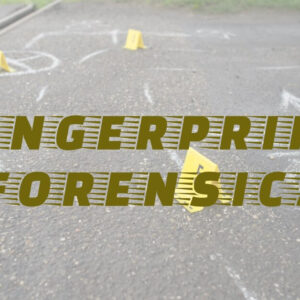In the realm of crime-solving, fingerprints act as miniature detectives. They possess a distinctiveness that belongs solely to each individual, aiding in connecting people to firearms or crime scenes. In the field of firearm forensics, where every single detail holds significance, fingerprinting plays a pivotal role.
Consider fingerprinting as a classic technique that has undergone modern enhancements. Traditional methods such as dusting for prints or utilizing specialized chemicals have received a technological makeover. Presently, we possess sophisticated tools like digital cameras and lasers that enable us to perceive fingerprints with unparalleled clarity.
Fingerprinting within firearm forensics holds immense importance. It assists in identifying suspects, establishing connections between guns and criminal activities, and maintaining a record of evidence. However, it extends beyond that; it symbolizes the trust we place in our justice system. With each fingerprint we examine, we move one step closer to unraveling the enigma of crime and ensuring that justice prevails.
Methods of Fingerprinting in Firearm Forensics
Fingerprinting methods in firearm forensics involve various techniques used to find, collect, and examine fingerprints found on guns, bullets, shell casings, and other surfaces. These methods, whether traditional or modern, are essential for pinpointing suspects, connecting firearms to criminal activities, and establishing a solid chain of custody. Let’s delve deeper into these methods.
1. Traditional Methods
a) Powder Dusting
Dusting with powder is a well-established and widely employed method in fingerprinting. It entails delicately applying a fine powder, like black or white fingerprint powder, onto the surface where the fingerprint is believed to exist.
The powder sticks to the oils and residues on the finger’s ridges, making the fingerprint stand out on the surface.
After that, forensic examiners meticulously raise and protect the print that has been developed by using special lifting tape or film to conduct additional analysis and comparison.
b) Chemical Enhancement
Chemical enhancement methods are utilized to uncover hidden fingerprints that the naked eye may not easily see.
Cyanoacrylate fuming also referred to as superglue fuming, is a commonly employed technique where the object believed to contain hidden fingerprints is placed in a chamber alongside a small quantity of cyanoacrylate ester. The vapor produced by the chemical reacts with the residues present in the fingerprint, making it detectable.
Ninhydrin serves as an additional chemical reagent employed to enhance hidden fingerprints, especially on porous materials like paper or cardboard. Upon application, ninhydrin interacts with the amino acids found in the fingerprint residues, resulting in the creation of a vibrant purple compound called Ruhemann’s purple.
2. Advanced Techniques
a) Digital Imaging
The process of fingerprint analysis has been completely transformed by the advent of digital imaging systems that come with high-resolution cameras and specialized software.
These advanced systems are capable of capturing highly detailed fingerprint images with remarkable clarity. This enables forensic examiners to zoom in, enhance, and analyze the intricate ridges and minutiae patterns with utmost precision.
Digital imaging makes it easier to create digital databases for storing and comparing fingerprint records, simplifying the process of identifying suspects and searching through databases.
b) Laser and Alternate Light Sources
Laser and ALS methods make use of particular light wavelengths, like ultraviolet (UV) or infrared (IR), to uncover hidden fingerprints that might not be seen under regular lighting.
UV light sources are great for finding prints on smooth surfaces, whereas IR light sources work well for picking up prints on shiny or dark surfaces.
Forensic investigators employ specialized filters and imaging devices to visualize and capture the hidden fingerprints exposed by these light sources, increasing the likelihood of identifying and analyzing crucial evidence.
Importance of Fingerprinting in Firearm Forensics
Fingerprinting plays a crucial role in firearm forensics, going beyond just identifying individuals. Here are a few key points that emphasize its importance:
1. Individualization and Uniqueness
Fingerprinting offers a level of personalization unmatched by any other type of evidence. The distinctiveness of each individual’s fingerprints allows for a direct connection to be made between a recovered print and a suspect, which can ultimately result in their identification and capture.
This high level of accuracy is essential in criminal cases, as it can help prove a suspect’s involvement at a crime scene or their handling of a weapon, which are crucial elements in constructing a solid case.
2. Reliability and Admissibility
Fingerprint evidence is considered very dependable and commonly used in legal proceedings. Unlike witness statements, which can be influenced by personal interpretation and mistakes, fingerprints provide an unbiased method of identification.
When handled correctly, recorded, and examined by skilled forensic professionals, fingerprint evidence holds substantial importance in court cases, frequently acting as convincing proof of a person’s participation in a crime.
3. Establishing Associations and Connections
Fingerprinting is extremely important in establishing connections and associations between people, guns, and criminal activities. By comparing fingerprints found on firearms, bullets, or crime scenes to those of known individuals, forensic investigators can gain valuable information about the circumstances of a crime.
This knowledge can assist in linking suspects, victims, and the weapons involved, ultimately helping to reconstruct events and identify possible motives.
4. Corroboration of Circumstantial Evidence
Fingerprinting plays a vital role in cases where other types of evidence may be inconclusive or indirect. For instance, if fingerprints are found on a firearm or its parts, they can support witness accounts or surveillance footage that places a suspect at the crime scene.
This corroborating evidence adds weight to the prosecution’s case, enhancing the credibility of other evidence presented during the trial.
5. Facilitating Investigations and Case Resolution
Fingerprinting speeds up the investigation process as it helps law enforcement agencies to swiftly narrow down their list of suspects. By comparing fingerprints found at the crime scene to databases of known criminals or individuals with previous records, investigators can quickly identify people of interest and concentrate their efforts on those who are most likely involved.
This effectiveness can greatly decrease the time and resources needed to solve cases, resulting in faster resolutions and justice for victims and their families.
Conclusion
Fingerprinting continues to be a fundamental aspect of firearm forensics, providing a powerful method for identification and gathering evidence in criminal investigations. As forensic science progresses, the techniques and methodologies used in fingerprint analysis will also advance, giving law enforcement agencies and judicial systems around the world even more tools to seek truth and justice.






